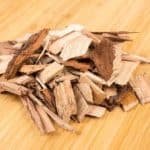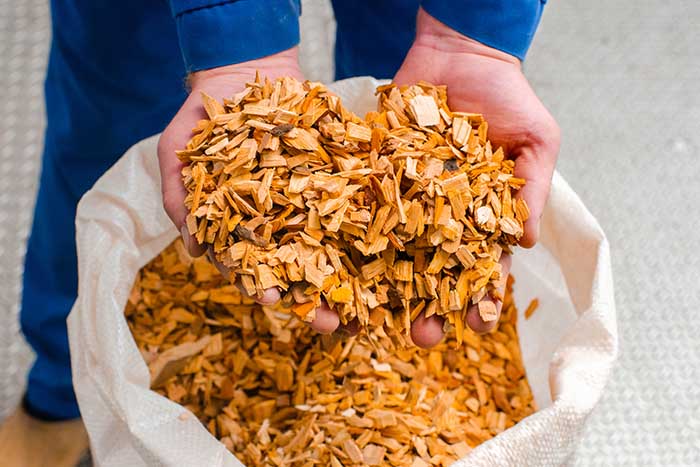Pear smoking wood is a hidden gem in the barbecue world, known for its subtle aroma and impressive burn duration. Discover how to use pear wood for your next barbecue cook-off.

The success of your smoke can hinge on your choice of smoking wood. While woods like hickory, mesquite and applewood might be long-time favorites of many pitmasters and barbecue fans, there’s one underrated type of wood that deserves a lot more love: Pear wood.
Pear wood for smoking can add a subtle sweetness and flavor note to your BBQ that not many other types of wood chip can. Perfect for smoked pork and poultry, it offers a distinctly sweet flavor with a touch of tangy and spicy notes.
From buying the right chips to getting the most out of your smoke, discover everything you need to know about smoking with pear wood. Let’s get cooking!

What is Pear Wood?
Pear wood gives off a sweet-tasting yet mellow smoke that won’t overshadow your seasoning mixture or the meat itself. It is well-suited to smoking lighter meats like poultry, game birds, salmon, and pork. It imparts a mild, sweet flavor to smoked meats, cheeses, and vegetables.
Pear wood is the wood of any species of pear tree. Although pear trees can be grown successfully in many parts of the United States, they are native to parts of Western Europe, Asia, and North Africa.
There are several pear tree species and thousands of individual pear cultivars out there, so you have plenty of options for smoking. If you’ve used fruit woods (e.g. apple, peach, cherry) for smoking before, you know that the most flavorful ones come from trees that produce edible fruits.
Pear wood also has a range of uses outside of smoking. Thanks to its hardness and overall durability, it’s a good choice for construction. It’s also used to make furniture and some musical instruments. It lends itself to carving and can sometimes be used to make intricate inlays.
Pear Wood Characteristics
Pear wood will give meats a pleasant, light flavor that is slightly sweet – similar to that of applewood. And just like applewood, it’s light and subtle. However, what really sets it apart is its undertones of spice and tangy notes. Applewood might be the safer bet, but pear’s complex notes can really enhance your barbecue smoked chicken, pork or seafood.
Despite its light flavor, pear is a very dense wood, so it has the advantage of producing sustained, even heat. Like apple, pear wood gives you the best flavor when you use slow, low heat. That way, your meat gets the full benefit of sweet and smoky flavors. It will be tender and juicy with the perfect crust.
What About Bradford Pear?
Keep in mind that not all pear woods are the same when it comes to flavor. If you’re in the eastern US, you might wonder whether you can use the ubiquitous Bradford pear tree. This flowering pear tree is commonly used as an ornamental despite the distinctly unpleasant odor of its blooms.
Bradford pear is a hardwood, so you can technically use it to smoke meats. However, when you’re using the woods of fruit trees like apple and pear, you want to use trees that produce sweet, edible fruits. The wood of these trees has the same sweet character, and it imparts that same flavor to meats.
Bradford pear trees do sometimes produce tiny fruits, but they’re generally considered to be inedible. If you smoke with Bradford pear wood, you’ll get a very mild flavor. In most cases, the wood of other species of pear trees will give you a much better flavor!
Is Pear Wood Good for Barbecue?
Pear wood is great for barbecue smoking for two reasons: One is that, just like many fruitwoods, it yields a mild and subtly sweet smoke that’s perfect for smoked chicken, turkey, pork, and seafood. It imparts the perfect level of flavor without overpowering the star of the show – your meat.
The other reason is that its dense composition gives it a well-measured burn rate, helping you with longer smokes for meats like whole turkey or pork butt.
How to Use Pear Wood
Pear wood might not be as common as some other varieties of wood, but it’s still relatively easy to find. You can use pellets or chips. Or, if you have an offset smoker, you can use small logs.
You can also chop your own pear wood if you wish. However, you don’t want to chop it and immediately throw it in your smoker. Aging (or ‘seasoning’) the wood is essential for flavor. The seasoning process takes some patience. You need to chop the wood, split it, and stack it. Keep it in a dry place like a shed or a garage, and wait six months.
There’s an easy way to tell if the wood is adequately seasoned: check the ends of the pieces. If you see cracks starting to form, it’s ready to go!
You can use pear wood on its own to smoke meats, but it also works nicely in blends. More specifically, it’s great for balancing out the bitterness of some other woods like walnut and oak.
Best Meats to Smoke with Pear Wood
Pear wood is well-suited to smoking lighter meats like poultry, game birds, salmon, and pork. (However, pork barbecue does better with more robust woods like hickory.) Pear’s distinctive sweetness is especially useful for balancing out gamey flavors.
Whether you’re already a fan of fruit woods or want to try something new, pear wood is great to add to your repertoire as a pitmaster. Try it alone or in your own blend!









